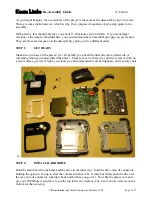
35 / 36
1) Connect the player to network and obtain an IP address first;
2) Please enable NetBIOS of TCP/IP on computer;
3) Please check your PC’s firewall settings;
4) Please enable your PC’s ‘Guest’ account;
5) Please share the folders which you wish to browse on your PC, and make sure that
‘Everyone’ or ‘Guest’ has the right to access.
Question 8. I configured everything correctly, but still cannot get the wireless network
or UPnP function to work.
Answer:
Are you using a firewall such as Norton Internet Security, McAfee Personal Firewall, Zone
Alarm, etc. or even the built-in firewall of Windows XP? (Don’t forget that Service Pack 2 for
Windows XP automatically upgrades your firewall and turn it on by default)
If you have a firewall, it may need to be configured or have exceptions created to allow you to
see and communicate with the player on the network. To test if your firewall is preventing
network communication (including PING and access shared folders), try disabling it to see if
you can connect. If you can connect with the firewall disabled, you may need to add the player
to the ‘Trusted’ list or configure the firewall for local intranet access. Worst-case, disable your
firewall long enough to use the player, then enable it again when done.
Question 9. I am using the 802.11n Wi-Fi dongle with an 802.11n wireless router, why
the speed is still 802.11g 54Mbps rather than 300Mbps?
Answer:
The IEEE 802.11n Draft standard prohibits using high throughput with WEP or TKIP as the
unicast cipher. If you use these encryption methods (e.g. WEP, WPA-TKIP), your data rate will
drop to 54 Mbps. You may contact the Access Point or router manufacturer to download the
latest firmware, or try other encryption methods (WPA2-AES or WPA2-TKIP), or choose to
configure an unsecured profile, but this option is not recommended.
6.3 Copyrights and Trademarks
Copyrights
All rights reserved
. No part of this manual may be reproduced, or transmitted in any form or
by any means, whether by electronically or mechanically, without the express written
permission from the copyright holder.
Copyrighted materials, such as software, music files, or movies, are protected by local law, and
may not be illegally copied or used without permission from the copyright owner.
Trademarks
Microsoft and Windows are registered trademarks of Microsoft Corporation.
All other trademarks are property of their respective holders.


































